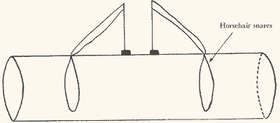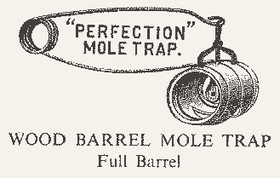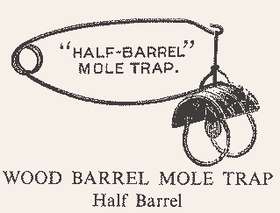Mole Traps, a brief history of mole traps and todays modern mole traps - part 2 (The half barrel type mole trap)
Half barrel mole trap with horsehair loops

Source: Moles & Their Control (Guy N. Smith)
As the evolution of mole traps unfolded, several types emerged as enduring favorites that continue to be widely used today. Naturally, their design has undergone significant transformations over the years, accompanied by improvements in the materials employed in the construction of modern mole traps. One such favored design in contemporary mole trapping is the half barrel mole trap. In its current iteration, these traps are constructed entirely from steel, incorporating sturdy wire loops and springs for enhanced durability and efficiency. This modernized construction represents a stark departure from their origins when half barrel mole traps were crafted from wood, featuring horsehair loops as the mechanism for capturing moles.
The enduring popularity of the half barrel mole trap underscores its efficacy in contemporary mole control strategies. Today's trappers benefit from the advancements in materials and design that have elevated these traps to new levels of reliability. The transition from wooden tubes with horsehair loops to the current steel structures with precisely engineered components highlights the continuous innovation in mole trap technology. This evolution not only reflects a commitment to improving the effectiveness of mole control methods but also pays homage to the historical roots that shaped these indispensable tools.
Full barrel wooden mole trap.

Source: Rural Reflections - a brief history of traps
Over the course of their evolution, wooden half barrel mole traps have undergone significant refinement and enhancement. In their earlier iterations, the traps featured horsehair loops or snares as the primary mechanism for capturing moles. However, with advancements in trap design and technology, these horsehair loops have given way to more durable and efficient wire loops. These wire loops are intricately connected to springs, introducing a more sophisticated and responsive element to the trapping mechanism.
The transformation of wooden half barrel mole traps extends beyond just the replacement of materials; it involves a fundamental shift in design and functionality. The integration of wire loops and springs not only contributes to the traps' longevity and reliability but also allows for a more precise and controlled capture process. As this evolution unfolded, two distinct types of traps emerged—the full barrel and half barrel variants. Each type was developed to address specific considerations, showcasing the adaptability and versatility of mole trapping methods. This continual innovation in trap design exemplifies the commitment to refining mole control techniques, ensuring that trappers have access to the most effective and humane tools available.
Half barrel wooden type mole trap.

Source: Rural Reflections - a brief history of traps
The half barrel wooden mole trap has stood the test of time with its distinctive design, proving to be a resilient and effective tool in the realm of mole control. Over the years, this trap has undergone various adaptations, a testament to both its enduring design excellence and the unique advantage it offers - the ability to capture two moles in a single trap.
The evolution of the half barrel wooden mole trap is a narrative of innovation and practicality. The initial design, rooted in simplicity, has seen thoughtful modifications to enhance its efficacy and utility. This adaptability has been particularly valuable in addressing the dynamic challenges of mole control, making the half barrel wooden trap a versatile choice for trappers seeking a reliable and efficient solution.
The remarkable feature of being able to catch two moles with one trap sets the half barrel wooden type apart, providing an added dimension to its functionality. This distinctive advantage not only speaks to the ingenuity of the trap but also highlights its efficiency in managing mole populations. As mole control methods continue to evolve, the half barrel wooden mole trap remains a stalwart choice, embodying a perfect blend of time-tested design and adaptability.
The Fenn double catch mole trap.

Source: Rural Reflections - a brief history of traps
The Fenn Double Catch Mole Trap represents a notable advancement in the field of mole control, featuring a unique double-catch mechanism designed to tackle mole infestations effectively. Engineered for precision and efficiency, this trap stands out for its user-friendly design, straightforward setup, and reliable performance. With its durable construction and innovative trapping technology, the Fenn Double Catch Mole Trap reflects a contemporary approach to pest control, emphasizing effectiveness, humaneness, and practicality in managing mole populations. Despite its noteworthy features, it's worth noting that the Fenn Double Catch Mole Trap never gained widespread popularity among mole catchers.
A more recent half barrel mole trap.

Source: Rural Reflections - a brief history of traps

